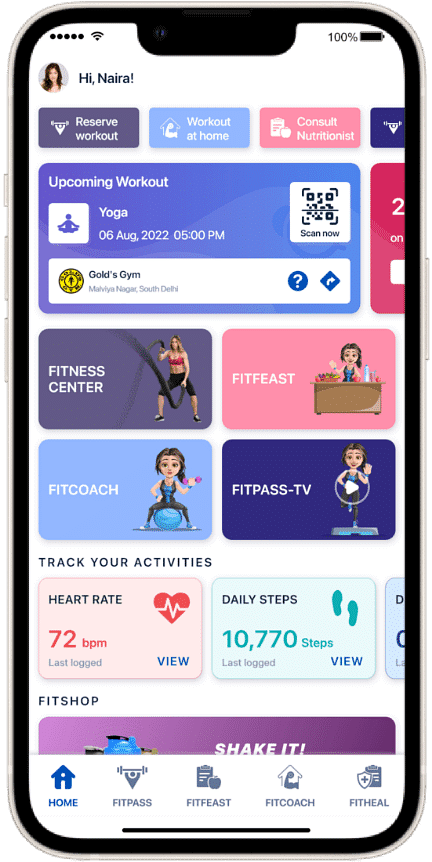Fitness for Diabetes: Active Tips on World Diabetes Day
Diabetes is a global health concern, affecting millions of people, and it’s growing in prevalence. This chronic condition, characterised by high blood sugar levels, requires careful management to prevent complications. One of the most effective ways to manage diabetes is through regular physical activity. Staying active can improve how the body handles insulin, help regulate blood sugar levels, and boost mental well-being. Let’s explore why fitness for diabetics is so crucial, which exercises are most effective, and some helpful World Diabetes Day fitness tips for getting started.
The Role of Fitness in Diabetes Management
Physical activity can be a powerful tool for managing diabetes and preventing its complications. Here are some ways fitness can make a difference:
Improved Blood Sugar Control
Exercise has a direct impact on blood sugar by helping muscles use glucose(sugar) for energy which helps improve the muscle’s ability to respond to insulin and process glucose. According to studies, even a short 10-15 minute walk after meals can significantly lower blood sugar levels. For those with Type 2 diabetes, regular exercise can even reduce the need for medication by enhancing insulin sensitivity.
Helping With Weight Management

Maintaining a healthy weight is especially important for diabetes management, as excess weight can increase the risk of insulin resistance. Physical activity helps burn calories, increases metabolism, and helps reduce or maintain weight. Not only does a healthy weight help control blood sugar, but it also helps reduce other health problems linked to diabetes, like heart disease. A balanced diet combined with fitness is a long-term solution to help prevent weight fluctuations.
Lowering The Risk of Heart Disease

Cardiovascular problems are much more likely to develop in people with diabetes, and heart disease is the leading cause of death among diabetics. Regular physical activity strengthens the heart and improves circulation, helping reduce blood pressure and creating a healthier cardiovascular system. Activities like brisk walking, swimming, or cycling are all good aerobic exercises to maintain heart health. The American Heart Association recommends at least 150 minutes of moderate aerobic activity a week for optimal heart and cardio for diabetes management.
Boosting Mood and Managing Stress

Having a chronic condition can be hard on your mental health and increase the risk of stress, anxiety and depression. Exercise helps release feel-good hormones like endorphins, which boost your mood and reduce stress. Stress, in turn, can affect blood sugar levels for diabetics just as much as physical health. Exercise can be a great way to stay positive, manage stress, and improve your mental well-being, whether you’re doing yoga, walking or dancing.
Best Exercises for Diabetes Management
People with diabetes can benefit from a variety of workouts, from cardio to strength training to flexibility exercises. Here’s a closer look at the best exercises for diabetes:
Strength Training for Diabetics

Strength training, like lifting weights or doing bodyweight exercises, is fantastic for building muscle, which uses up more glucose than fat and helps keep blood sugar stable. More muscle mass means more muscle tissue, which means your body can better manage blood sugar since muscle tissue uses more glucose than fat. Squats, Lunges, and even lifting light weights can be done 2-3 times a week to improve insulin sensitivity and help maintain glucose regulation.
Cardio for Diabetes Management

Cardio exercises, or aerobic activities, are great for cardiovascular health and maintaining a healthy weight. Walking, cycling, swimming, or even dancing will increase heart rate and improve lung function, which is good for health in general. For the best results, the American Diabetes Association recommends at least 150 minutes of moderate-intensity aerobic activity per week.
Yoga for Diabetes Management

Yoga is not only calming but also improves flexibility, strength, and balance. Studies have shown that regular yoga practise can help reduce blood sugar levels and relieve stress - both key elements of diabetes management. Beginners can start with simple poses like “cobra” and “warrior” poses are accessible and effective ways to start with yoga.
At-Home Workouts for Diabetics

If going to a gym is challenging, at-home workouts can be just as effective. Bodyweight exercises like squats, push-ups, or resistance band workouts can be done in small spaces with little to no equipment. Even a short walk around the house or a few minutes of stretching can keep your energy up and your blood sugar levels steady.
Staying Active on World Diabetes Day: Simple Tips for Diabetics
World Diabetes Day is a perfect time to kick-start a fitness journey. Here are some practical workout tips for diabetics:
Start Small and Gradually Increase
If you’re new to working out, it’s best to start small. A good starting point is simple things, such as stretching or light walking. Then, start to increase the added intensity or duration of your activity moderately. Consistency is key; even 10 minutes a day can help your health in the long run. As your fitness improves, consider adding resistance or duration to your workouts for continued progress.
Incorporate Exercise into Daily Routine

It’s hard to exercise regularly, but making it a part of your daily routine will help you stay consistent. All of these small changes add up. Take the stairs, park a little farther from your destination, or stand up and stretch every hour. These little activities add up and make it easier to stay active.
Choose Activities You Enjoy
Exercise doesn’t have to be a burden, it can be fun. Choose activities that make you feel good, whether dancing, cycling, swimming or yoga. If you’re doing something you love, sticking with it and turning it into a lasting habit will be easier. Another way to make the process more enjoyable is to keep variety in workouts.
Consult with a Healthcare Professional

Before starting a new fitness plan, it is important to speak with a healthcare provider. A professional will help you with safe exercises and tailor fitness plans for diabetics based on your health needs. They can also help monitor your progress and adjust your fitness plan as needed to keep you safe and effective.
Conclusion
Incorporating fitness tips for managing diabetes into your lifestyle can significantly improve health outcomes. From strength training for diabetics to yoga and daily activities, regular exercise has multiple benefits, including better blood sugar control, weight management, and mental well-being. This World Diabetes Day, take the first step towards a healthier life by prioritising physical activity. Consult with your healthcare provider, set realistic goals, and, most importantly, have fun while staying active.
Remember, small changes can make a big difference. So, get moving, stay motivated, and explore the world of fitness for diabetics with confidence.

What are the best exercises for diabetes management?
Best exercises for diabetes include walking, cycling, and strength training. These exercises aid blood sugar control, heart health, and weight management, all key for managing diabetes effectively.
Can strength training help in managing diabetes?
Yes, strength training for diabetics builds muscle, improving glucose use and insulin sensitivity. Exercises like squats and light weights support blood sugar regulation and are ideal for diabetes management.
Why is fitness important for people with diabetes?
Fitness for diabetics supports blood sugar control, aids weight management, and reduces heart disease risk. Exercise also boosts mood, reduces stress, and improves insulin sensitivity.
How does exercise help with diabetes management?
Exercise improves insulin sensitivity and helps muscles use glucose, lowering blood sugar levels. Regular activity can reduce insulin resistance, making blood sugar control easier for diabetics.
Are there at-home workouts suitable for people with diabetes?
At-home workouts for diabetics include bodyweight exercises, resistance bands, and yoga. These improve flexibility, lower stress, and help control blood sugar without needing a gym.


